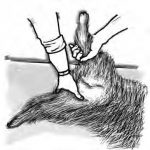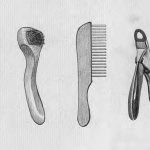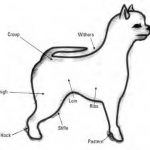In Search of Your Soul Mate

In This Chapter
- Shopping for pink or blue: Gender issues
- Checking out the age differences
- Looking good on paper: Pedigrees
- Recognizing a good Pom source
- Rescuing a Pom
Boy or Girl? Choosing the Right Gender for You
Remember
Whether you choose male or female is primarily a matter of preference. Gender doesn’t indicate personality even though some people consider males to be more loving and females to be a little smarter. But these are broad generalizations; you can easily end up with a cuddle-loving female or a smart-as-a-whip male. And although females tend to be a little smaller, the difference is somewhere between tiny and teensy. Unless competing for the world’s smallest dog is your goal, size isn’t a big consideration when choosing your Pom’s gender. A bigger concern is a Pom in heat.
Age Matters: Choosing Your Match
The benefits and drawbacks of maturity
Remember
Rescue groups also have adults available. In fact, always consider a rescue when considering a new adult dog. (See the end of this chapter and Chapter The Final Selection: Picking Your Perfect Partner for more information on rescued Poms.)
– Affection: Some people are concerned that an adult dog won’t form the attachment to you that a puppy would. Fear not — Pomeranians form bonds very quickly. Within a short period, your adult Pomeranian will feel like she’s owned you all her life.
Warning!
If the dog’s really shy or aggressive, though, she needs a more experienced owner. You don’t do yourself or the dog any favors by taking on a challenge that you don’t know how to manage.
– Behavior: Mature Poms are often already housetrained, but whether they catch on depends on how they’ve been living. If they’ve been in a kennel, they’re usually easier to housetrain than if they’ve been running loose in the house untrained. Regardless, they’re generally past their destructive chewing stage, although a few errant chews may still happen. Senior Poms don’t need to be fed every few hours or walked every few minutes, and they even know a cool trick or two.
– Habits: Of course, older dogs may still have bad habits like using the bathroom where they want, barking at shadows, or ignoring your calls. They may have come from bad situations such as puppy mills or abusive homes, where they received bad training (or none at all). For these reasons, find out as much as you can about an older dog’s background before you bring her home. Taking on more than you can handle isn’t fair to either of you.
– Health: How is his health? The older the dog, the more likely health problems are to show up. As your last step, have a veterinarian examine him. If the dog has health problems, the veterinarian may be able to advise you as to whether the problems will worsen.
The joys and trials of youth
– They learn to do things your way. Simply put, it’s a lot easier convincing your new dog that your way is the right way without her pointing out, “That’s not how they did it where I used to live!”
– You can train your dog to do special tasks or live in special circumstances. You may have a special job planned for your Pom (like being a therapy dog) or simply special requirements (like living with cats or other pets). Exposing her to any special circumstances early in life helps her take them in stride later on.
Deciding Whether Two Poms Are Better Than One
Tip
If you decide to get two pups, you’ll find that opposite sexes tend to get along the best. Note: That suggestion is assuming you plan to have them spayed and neutered. Otherwise, opposites become too attractive and it’s a mistake. Besides, most good breeders don’t sell what may appear to be a breeding pair of pet-quality puppies (see the following section for more about this term) unless you agree to early spaying and neutering. Responsible breeders don’t want you rushing off to breed puppies, whether irresponsibly or naively.
Considering Your Goals: What Pom Type Would You Like?
Pet (or companion) quality
Remember
A pet-quality dog is still in good health and has a good temperament. Being a pet or companion is the most important role any Pom can assume, so it’s the very best quality for most people.
Technical Stuff
Good breeders usually sell pet-quality puppies with the requirement that that they be spayed or neutered or that they be registered with AKC limited registration (see Chapter The Final Selection: Picking Your Perfect Partner). If your dog does turn out to be higher quality than initially guessed, only the breeder can change the limited registration to full registration. Of course, no one can un-spay or un-neuter the dog! Regardless, spayed, neutered, or limited-registered dogs can compete in every other venue of competition except conformation showing.
Show quality
– Flaws may emerge at a later age. Maybe a puppy keeps on growing and growing or the coat falls out. Hey, nobody’s perfect. Dog shows are fun, but they make up only a miniscule part of the time you share with a dog. Don’t let it bother you, and try competing in one of the many other areas open to you and your Pom.
Remember
– Be fair to the breeder. If you buy a show-quality dog, plan to show it. Hobby breeders work hard to produce these showquality puppies. Their payback isn’t the purchase price but the thrill of seeing their protégés win in the show ring, especially for a novice owner. Promising to show their future star and then hiding him from the world is not good form.
– You need to earn the breeder’s trust. If you’ve never shown a dog before, most breeders will be hesitant about entrusting you with a top show-quality puppy. A good way to earn their trust and respect is to earn an obedience title with another dog, perhaps by first buying a companion-quality puppy.
Breeding quality
Warning!
If a breeder tries to tell you a tiny puppy is breeding quality, the breeder probably has little idea of what breeding quality really means (except the ability to produce puppies). A show-quality dog is difficult to identify as a puppy; a breeding-quality dog is impossible.
Perusing Pedigrees
Early spay-neuterMany adoption groups and some breeders sterilize puppies before they’re adopted, even if that means as early as 8 weeks of age. They take special precautions (minimizing surgical time, keeping the puppy warm, withholding food for as short a time as possible, and being extremely careful with their comparatively delicate tissues) to avoid hypothermia, hypoglycemia, and excessive bleeding in the pup. Given these precautions, puppies sterilized at early ages have shorter recovery times and fewer complications than pups sterilized later. Some limited information suggests that females spayed at a young age have a higher incidence of urinary incontinence, but that tends to be more of a problem in large breeds. |
Warning!
Look especially for whether the litter is inbred (the litter has the same dog appearing behind both the sire and the dam). Fewer generations between that dog and the litter generally mean a more-inbred litter. See Figure 3-1 for a sample pedigree of an inbred dog — this is what you don’t want to see.
Evaluating Pom Sources
– Pet stores (supplied by commercial breeders)
– Backyard breeders (found usually through newspaper ads)
– Serious breeders (also known as hobby breeders)
– Rescue groups and shelters
Pet stores and commercial breeders
Warning!
Some pet stores rely on uninformed buyers who don’t know:
– Puppies are hauled across country to the stores by the truckload.
– These pups come from large, commercial-breeding operations that often keep hundreds of dogs in cramped cages, sometimes in squalid conditions.
– This breeding stock is bought and sold at auctions, with low price usually being the deciding factor.
– Poor temperaments, poor resemblance to the breed, poor structure, and poor health don’t matter; it’s all about profit.
Remember
Not every commercial breeder has such bad conditions. Some of these breeders realize that the best way to raise salable puppies is to produce puppies under healthy circumstances. The problem is that you can’t tell which puppies come from which type of commercial breeder after the pups are in the pet store.
Newspaper ads and backyard breeders
– He may keep dogs of different breeds, selling the puppies to make extra money.
– He puts up roadside signs advertising puppies and even sells puppies at flea markets.
– He keeps the dogs in poor conditions, seldom has their health tested, and provides minimal socialization for the dogs.
Tip
Ferreting out a bad-news backyard breeder is easy: Ask whether he’ll have other litters coming any time soon. If he replies, “Sure, what breed would you like?” tell him “None.”
Beware the claims of rareIf a breeder claims a dog is rare because of color, size, or an unusual trait, this statement should raise a caution flag. Some colors are more common than others, but no Pom color is rare, and certain colors don’t make a dog more valuable. The same is true of size. The Pomeranian standard specifies the average weight to be 3 to 7 pounds (4 to 6 pounds for show dogs). Within this range, one size is as good as another. Smaller sizes can be more difficult to keep healthy, so aim for the top of the standard. |
Hobby breeders who are really serious
– National Clubs: The best place to start is the American Pomeranian Club national breeder referral list (go to www.americanpomeranianclub.organd click on APC Info and then Member Roster). You can find contact information for local members who may be breeders or who can direct you to breeders.
You can also contact the club’s national breeder referral person by clicking on APC Info and then Breeder Referral Info. The breeder referral person often knows who has litters in your area or who has litters of various colors if you have a preference. Most, but not all, hobby breeders are members of the national breed club.
Joining the club means agreeing to a code of ethics that covers integrity in breeding. Of course, signing the code doesn’t guarantee people will follow it any more than joining the club makes them magically good breeders. But it’s a start.
– Regional Clubs: In addition to the national club, many regional Pomeranian clubs exist. (The national site can refer you to a regional club in your area; click on APC Info and then Regional Clubs.) Getting to know local Pomeranian breeders is one of the best ways to meet their dogs in person and to let the breeders know what a good home you have for one of their puppies.
– Dog Shows: Another way to meet breeders is by attending a local dog show. You can find upcoming shows at the American Kennel Club’s Web page for upcoming events at www.akc.org/events/search/ or check out www.infodog.com. The latter site also includes the specific times Pomeranians are shown at particular shows.
Remember
Although Pomeranian exhibitors are usually happy to talk to you, the one time they’d rather not chat is right before they go in the ring. Make arrangements to talk to them after judging is over.
– Dog-Specific Magazines: Several sources are available.
- A Pomeranian magazine like The Pom Reader or a magazine aimed at toy breeds like Top Notch Toys are excellent places to find top breeders. Go to www.dmcg.comfor more information.
- All-breed dog magazines like Dog World (www.animalchannel.com) also contain advertisements from hobby breeders.
– Veterinarians: Local veterinarians can often be a good source. After all, they know breeders, so they know which breeders take good care of their dogs!
– Internet: You can join one of the many Pomeranian discussion lists on the Internet. Start your search at www.yahoogrops.com and look for breeders there, but you must evaluate these breeders carefully.
Finding Good Breeders
– You can always ask questions, share anecdotes, and find help at a moment’s notice.
– You find that you’re part of an extended family of puppy owners, and you can keep up with littermates throughout their lives.
– If circumstances arise that force you to surrender your dog, a good breeder is there to make sure your dog’s taken care of.
– Can I visit in person? Good breeders may actually require that you visit in person so they can meet you and see how you interact with the dogs. The breeder has no valid reason for not allowing you to visit except if you have a sick dog at home. If they say “No” to a visit, say “Good-bye,” hang up, and dial the next number on your list.
– Do you specialize in Pomeranians? Dealing with one breed is so challenging that serious breeders stick with the breed they’re passionate about. Unless she’s building an ark, a breeder who has two of everything (multiple breeds) is more likely a small-scale puppy mill. (Check back to “Newspaper ads and backyard breeders” for more on this breed of breeder.)
– Do you always have puppies available? Breeders who always have puppies may not be able to give each litter the attention it needs. You want your puppy to experience the breeder’s home, not just his kennel or garage. However, if the breeder has years of experience, a great deal of success, the proper facilities, and good help to make sure the dogs are properly cared for and socialized, then the constant breeding may not be an issue.
– Are the dogs registered with the AKC or United Kennel Club (UKC)? A good breeder registers her dogs. Although other registries exist, only the AKC and the UKC are considered reputable.
– What sort of health concerns do you screen for? If they claim Pomeranians have no such concerns, you know you’re dealing with the wrong people. If they say Poms need no health screening, walk away. If they say they’ve had a couple of problems, keep listening. No line is completely free of health problems, and you may have just met an honest breeder.
But at the same time, be careful. You may have just met a really stupid breeder who doesn’t know any better. See Chapter The Final Selection: Picking Your Perfect Partner for a list of tests to look for.
– Do you participate with your dogs in conformation shows, agility trials, obedience trials, or therapy work? Have the dogs earned any titles? Participation indicates an above-average commitment to the breed. Titles indicate an above-average dedication to the breed plus better-than-average quality of the dogs (Refer back to “Considering Your Goals: What Pom Type Would You Like?” for definitions of quality.)
Remember
– Can I see the pedigree? The pedigree should always be available for inspection. If it’s not, this is not a reputable breeder.
– What sort of paperwork comes with the puppy? Several kinds of paper should be available:
- You can expect a medical history, a pedigree, and a registration slip.
- A good breeder also includes written care instructions, a contract, and a warranty.
No breeder can guarantee everything, but he should warrantee the puppy’s health for the first week and perhaps offer a partial refund in the event of certain hereditary diseases.
A contract should cover a plan for the puppy if you can’t keep her. For example, a good breeder stipulates that you must return the puppy to the breeder to prevent the puppy ending up in a shelter or being passed from person to person. Note: In most cases the breeder does not give a refund for a returned puppy that’s grown up because placing an adult dog is usually difficult.
Warning!
– Do you have any breeding requirements? Some breeders require you to breed your dog and then share the litter with them or to provide free stud service. This is never a good idea. You may wish to spay or neuter your dog, and you don’t want to be obligated to breed.
– Do you require that the puppy be spayed or neutered? This is not an issue about competition. Good breeders often require you to spay or neuter your dog because they’re concerned about the future of the puppy and the breed. The dog they sold you is probably companion quality, which means she’s a wonderful dog but not show or breeding quality; as such, she shouldn’t be bred.
Good breeders are also concerned about your taking the plunge into breeding. Breeding responsibly and knowledgably isn’t something you can just jump right into, and you may end up being sorry you ever had such a foolish idea.
An alternative to required spay-neuter is AKC limited registration, which means that if you breed your dog, her offspring can’t be AKC Registered.
– When can I take a new Pom puppy home? The answer to this question is an opportunity to evaluate the breeder. Breeders out for a buck are eager to get a puppy off their feed bill as soon as possible. Backyard breeders who don’t know any better may also let you take home your puppy whenever you want. No puppy of any breed should leave its breeder before 8 weeks of age. For more info on when the pup can leave the breeder, see Chapter The Final Selection: Picking Your Perfect Partner.
– How much do puppies cost? Good breeders charge neither bargain-basement prices nor exorbitantly high prices in comparison to other breeders. Although prices vary by region of the country, a good companion-quality Pomeranian from a reputable breeder should cost $300 to $900. See Chapter The Final Selection: Picking Your Perfect Partner for more details on price.
– Do you have any previous puppy buyers I can talk to? Good breeders keep in touch with their puppy buyers. If they claim not to have any contact information, that’s a bad sign. Good breeders are also proud of their puppies and know their puppies’ owners are proud, too. For privacy reasons, they may ask that the former buyers contact you rather than vice versa. But if they flat out say “No,” walk away.
Remember
As you check out serious breeders, you may quickly discover that they’re also evaluating you! In fact, if you don’t feel they’re curious about you as a potential pet owner, it can be a red flag. For example, when a breeder only seems concerned about your check clearing, you may want to move on to another breeder.
– They ask about your experience with dogs and pets in general and toy dogs in particular.
– They ask about your home and family and where you plan to keep the dog.
– They’re very upfront with you about expenses, exercise, training, grooming, health care, and safety issues.
Tip
– They often require that you neuter or spay your dog, and may ask you to wait for several months for a litter. During this cooling off period, they’re making sure you’re not just impulse buying.
Rescuing Abandoned Poms
Remember
You may fear that adopting a rescued Pom means taking on somebody else’s problems or that rescued dogs come with emotional baggage. These occurrences are rare. In fact, the top obedience Pomeranian of all time was rescued at 8 years of age from an animal shelter.
Tip
A rescued Pomeranian is the deal of a lifetime but certainly not free. Because rescue groups realize that people tend to value pets that they’ve invested in and because these groups need to recoup their expenses to continue the services, they charge a reasonable fee. Expect to pay about $200 or so for a Pom from a rescue group.
To the rescue!Even if you can’t take on the long-term responsibility of a dog, you can do your part for rescue. Rescue groups always need supplies, money, and volunteers. Volunteers can help rescue, bathe, groom, socialize, train, and transport Pomeranians. Most of all, volunteers can help foster by providing a temporary home while a Pom awaits a forever home. |
– The American Pomeranian Club: The club maintains a national rescue network that you can access through their Web site at www.americanpomeranianclub.org. Click on APC Info and then Rescue. The Rescue link also lists local rescue contacts around the country.
– Petfinder: This group maintains a national database of dogs of all breeds in shelters. Go to www.petfinder.com and search by Pomeranian.
– Pomeranian Club of Canada Rescue (Canada): Access this group through their Web site at www.toyrificpoms.com/pomrescue/index.htm. This group focuses on Poms in Canada.
– Pomeranian and Small Breed Rescue (Canada): You can reach this group at www.psbrescue.com.
by D.Caroline Coile,Ph.D.


































